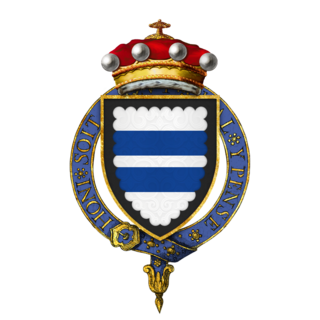Related Research Articles
Sir John Guildford, JP, of Hemsted in Benenden, also written Guilford, was an English landowner, administrator and politician.

Sir William Parr, KG (1434–1483) was an English courtier and soldier. He was the eldest son of Sir Thomas Parr (1405–1461) and his wife Alice, daughter of Sir Thomas Tunstall of Thurland, Lancashire.
Sir James Harington of Exton was a 16th-century English public servant who fulfilled a number of legal, legislative and law enforcement duties and was knighted in 1565.
Tunstall is a linear village and civil parish in Swale in Kent, England. It is about 2 km to the south-west of the centre of Sittingbourne, on a road towards Bredgar.

The Hales Baronetcy, is a title in the Baronetage of England. There were three Hales baronetcies. The oldest was created in 1611 for Edward Hales. He was a member of a Kent family. The second was created in 1660 for Robert Hales, MP for Hythe 1659, also of a Kent family. The third was created in 1660 for John Hales of Coventry, co. Warwick.

Sir Thomas Parr of Kendal in Westmorland, England, was a courtier and is best known as the father of Queen Catherine Parr, the sixth and final wife of King Henry VIII.
Sir William Hawte was a prominent member of a Kentish gentry family of long standing in royal service, which, through its near connections to the Woodville family, became closely and dangerously embroiled in the last phases of the Wars of the Roses.

Scot's Hall was a country house in Smeeth, between Ashford and Folkestone in southeast England. It was the property of a gentry family, the Scotts. The first known resident was Sir John Scott, who married Caroline Carter.
Sir Edward Hales, 1st Baronet (1576–1654) was an English politician who sat in the House of Commons in various years between 1605 and 1648. He supported the Parliamentarian side in the English Civil War.

Sir Moyle Finch, 1st Baronet JP was an English politician, knight, sheriff, and MP.

Sir John Fogge was an English courtier, soldier and supporter of the Woodville family under Edward IV who became an opponent of Richard III.
Sir Drue Drury was the son of Sir Robert Drury, the grandson of Sir Robert Drury, Speaker of the House of Commons, and the nephew of Sir William Drury. He was an English courtier and politician who sat in the House of Commons at various times between 1562 and 1584.
William Haute (1390–1462) of Bishopsbourne, Kent, was an English politician.
Sir Edward Hales, 2nd Baronet was an English politician who sat in the House of Commons from 1660 to 1681.
Sir Edward Wotton (1489–1551) was the Treasurer of Calais and a privy councillor to Edward VI of England.
Thomas Wotton (1521–1587), was a sheriff of Kent, the son of Sir Edward Wotton and father of Edward Wotton, the 1st Baron Wotton. He was the brother of William Wotton. His aunt Margaret was married to Thomas Grey, 2nd Marquess of Dorset.
Sir Thomas Bishopp, 1st Baronet (1553–1626), also spelt Bishop and Bisshopp, was an English politician.
Richard Lestrange of Hunstanton and King's Lynn, Norfolk; later of Kilkenny, Ireland, was an English politician.
Sir John Guildford, was an English landowner, administrator and politician from Kent.

The title Baron Cobham has been created numerous times in the Peerage of England; often multiple creations have been extant simultaneously, especially in the fourteenth century.
References
- 1 2 3 4 Hasted, Edward (1797). The History and Topographical Survey of the County of Kent. Vol. 2. pp. 575–6.
- ↑ "RUDSTON, Robert (1514/15-90), of Boughton Monchelsea, Kent" . Retrieved 28 December 2023.
- 1 2 3 4 "CROMER, William (c.1531-98), of Tunstall, nr. Sittingbourne, Kent" . Retrieved 28 December 2023.
- ↑ Nichols, John (1823). The Progresses and Public Processions of Queen Elizabeth. Vol. 1. p. 353.